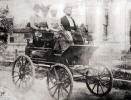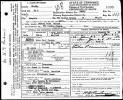|
Samuel T. Carnes
...
the Telephone,
Electricity,
and
the Automobile
|
|
|
|
|
|
An 1899 Memphis Newspaper states,
"Perhaps no man in all the city of Memphis is better, more widely or
more favorably known than Samuel T. Carnes."
But
today
ask any Memphian about Samuel T. Carnes, and they most likely
will reply "WHO?" Yet this generally unknown Memphis
businessman was the gentleman responsible for bringing
Electricity to the city ... and then the Telephone ... and then
introduced the first automobile. And there's more ... This
page hopes to bring attention to this pioneer who was the
architect of his own destiny and rose from "nothing" to accumulate a
large fortune. |
 |
|
|
|
|
|
|
|
|
|
|
|
|
Click on small
photos to see an enlargement |
|
|
|
|
|
|
|
 |
Samuel
Tate Carnes was born in Hardeman County, West Tennessee, in 1850
and spent his life in Memphis. By birth he was a soldier.
His father was General James A. Carnes who was a merchant
and land owner as well as brigadier-general of the state militia
before the Civil War. When war broke out, he was made a
General. He died in 1863 at Charlotte, South
Carolina leaving an insolvent estate. Samuel's mother
Elizabeth M. (Jones) was the only child of General William Watts
Jones of North Carolina, a soldier in the Revolutionary War.
Samuel's older brother William, was a Captain in the Confederate
Army. |
| Hardeman Co,
Tennessee |
|
|
|
|
|
|
|
|
|
|
|
Samuel was
in school when the war began and his studies were halted.
After his father's untimely death, he was penniless and was forced
to give up all thoughts of schooling, By 1866 he had
moved to Memphis where he would seek employment and remain for the rest of his life.
Although now virtually uneducated, 16 year old Carnes was bright and
quickly found employment at the Savings Bank of Memphis, where he
began as a "runner" and was quickly promoted to
collection clerk, and then to Bookkeeper,
Other jobs followed about every year or two, and each was
accompanied with a salary increase |
 |
| |
Samuel T.
Carnes |
|
|
|
|
In 1868 he was bookkeeper for Copperthwaite, Chapman & Co , and
then the Gage & Fisher Cotton Firm; G.
Falls & Co Cotton Buyers; bookkeeper for Hill, Fontaine & Co,
and in
1877, Clark, Johnson & Co Grocers and Cotton Factors.
Memphis was going through "reconstruction" as well as major "growing pains"
during this period. And Carnes was getting richer. |
|
|
|
|
|
|
|
|
|
|
|
 |
In 1881 S. T. Carnes married Miss Katherine Burke Kerr. They moved into a
beautiful mansion at 451 Linden Avenue (at Wellington) and
named it Lindencrest. It was considered one of the
show places of the last generation. In 1882 and 1884
the Carnes welcomed daughters Kate and Juliet. Katherine
and Samuel were very active socially and their names were
frequently mentioned in the social columns ... as well as
all of Samuel's business activities. They
lived at Lindencrest until their deaths. |
|
Katherine
Kerr |
In 1941 the Commercial Appeal reported the home was scheduled to be converted into a
"Negro
clinic and headquarters for the Memphis Department's Negro
Activities". The home has since been demolished. |
|
|
|
 |
 |
 |
 |
 |
 |
| Marriage |
1900
Census |
Lindencrest |
Lindencrest |
Lindencrest c 1932 |
1929 |
|
|
|
|
|
|
|
|
|
1878:
Carnes brings the Telephone to Memphis ...
In the fall of 1878, S. T. Carnes secured the right from the
Bell Telephone Company for an exchange in Memphis, and he built
the exchange that same year - one of the first in the
country. In 1881 he organized the Memphis Telephone
Company and was made president and general manager of the
company. He carried on this business for five years,
selling out at the end of this period to Cumberland Telephone
Co. |
 |
| |
1880s
Telephone |
|
|
|
|
When
the first telephone call was made in Memphis, it was from the railway office
of Col Michael Burke to the home of Henry A. Montgomery on
Poplar Avenue.
Montgomery owned a telegraph service and had laid the first
telegraph cable across the Mississippi. Thus he had the area's first
and only telephone.
The
second and third phones were later installed in Col Burke's home and
in his office. |
|
|
 |
 |
 |
 |
 |
 |
| 1890s
Telephone |
Marker |
1883 Directory |
Montgomery
Home |
H.
Montgomery |
Montgomery
Park |
|
|
|
|
H. A.
MONTGOMERY HOME:
Located on the
Corner of Poplar-Montgomery, it was built in the 1860's. The
beautiful home was the site of many lavish parties, including an 1882 reception for Oscar Wilde.
Montgomery was also the founder of Montgomery Park. His home was
demolished in 1928 to provide additional space when Memphis
Technical High School was built.
Sadly,
with the rising demand for business and home telephones,
some of the world's most unsightly telephone and electrical
poles were installed on the Memphis streets. |
 |
| |
Telephone Poles |
|
|
|
|
|
|
|
|
The
unsightly "pole situation" was so bad that the National
magazine McCall's did a photo feature on them in 1906. |
|
|
|
|
|
|
|
1882:
Carnes brings Electricity to Memphis ...
The
paving of streets in Memphis with asphalt improved
transportation in the city. Carnes created a new asphalt
company to provide this service. And he had sold his
Telephone Company to take charge of the new Electric Co of Memphis
which he had organized. In 1882 the Electric Co. was incorporated as Brush Electric Light and
Power Company of Memphis and Carnes was elected president and
general manager. Within a year it was serving 35 customers
and Carnes guided this large plant he had created, through
its experimental stages. This new business
secured a 10 year charter from Memphis to provide local service,
and monopolized electrical service in the city for the next 20
years. |
 |
|
|
|
|
|
|
|
|
|
|
 |
As
early as 1881 a generator operated one light over a door of one
Memphis Business. But after Carnes built his electric
plant in 1884 on Jefferson Avenue, the lighting of Memphis began. There suddenly appeared amazing lighted signs
above downtown businesses. Folks would stand for hours and stare at
them. And then came electric streetlights making the
downtown area as bright as day. By 1895, the street cars
were no longer pulled by horses. They were now electric. And electric
motors revolutionized local industries ... |
|
Amazing electrical signs |
|
| |
|
|
|
|
|
|
|
|
1901:
Carnes introduces the first automobile to Memphis ... |
|
|
 |
S. T.
Carnes took a daily streetcar from his home on Linden to his
office at 300 Second Street. It's not surprising that in
1901 he would purchase the first automobile to appear on the
streets of Memphis. And since that auto looked exactly
like a carriage without the horse it was referred to as a
"horseless carriage". But the machine was actually
called "MOBILE" and it sold for $750, an outrageous price
considering that an average yearly wage was $500. But now,
Carnes was rich, and he looked to the future. It must have
been a sight seeing the Carnes family in their mobile, on the streets of Memphis
with all the horses, carts, wagons, and carriages. The
top speed was 5 miles per hour. The rest is
history. |
|
"Mobile" |
|
|
|
|
 |
 |
 |
 |
 |
|
Carnes Family 1901 |
Memphis Carriages 1895 |
Memphis 1895 |
Memphis 1899 |
Memphis 1902 |
|
|
|
|
|
|
|
|
Carnes and the Chickasaw Guards ... Carnes and the Coal Creek riots
... |
|
In 1878 Carnes began an association with the Memphis Chickasaw
Guards, and from 1878 to 1891 was Captain of the Guards.
He served with the Guards for 13 years and during this period
this military company had a record second to no similar
organization in the United States. The company was more successful in
drill contests in various cities, north and south, and was better
known than any other drill organization in the United States.
Even Gen. Sherman pronounced them "... superior to anything in
or out of West Point." |
 |
| |
|
|
When the
National Guard law was passed, Carnes was made colonel of the 2nd
Regiment. In 1892 he was made brigadier general and was placed
in command of the state troops - a position he resigned in 1896.
During this period he took part in the Coal Creek riots, and with no
instructions and by acting on his own judgment helped resolve the
unrest with the miners of East Tennessee - without blood shed.
|
|
|
|
|
|
|
|
 |
|
 |
 |
 |
|
1895 NY Times |
|
Rules of the
Inter-state Drill Competition - 1895 |
|
|
|
|
|
|
|
|
Samuel Tate Carnes lived a full and by all accounts an honorable
life. This truly self-made man died in 1932 at the
age of 81. The cause of death was pneumonia. Burial
at Elmwood Cemetery. |
 |
 |
 |
| |
S. T. Carnes |
Death notice
- 1932 |
Certificate
1932 |
|
|
|
|
|
| |
|
The Carnes Extended Family |
| |
 |
William W. Carnes
William,
the brother of Samuel,
was born in Somerville, Tennessee in 1841. He was a
student at the US Naval Academy when the Civil War began and he
resigned and joined the Confederacy as a Lieutenant. He
was soon promoted to Captain and achieved some fame as an
artillery officer for his heroism. After the war he made
Macon, Georgia his home and lived there for 21 years, running an
insurance business. In 1888 he returned to Memphis, and at
one time was elected sheriff of Shelby County. Other times
he was associated with the businesses of his brother Samuel
Carnes. William and his first wife, Kate had 3
children. After her death in 1872 he married her sister
Lila. They had 8 children. He died in 1932 and is
buried at Rose Hill Cemetery, Macon, Georgia. |
| Wm. W. Carnes |
|
|
|
|
|
Katherine Kerr Carnes Livermore and Dr. George
Robertson Livermore:
Katherine
was two years older than her sister Juliet. Both girls
married well and Katherine married Memphis Dr. George Robertson
Livermore. They had two children. Dr.
Livermore was the attending physician at the death of Samuel
Carnes.
(Bio from University of Virginia and.
Bio from Who's Who in
Tennessee) |
 |
 |
| |
Katherine |
George |
|
|
|
 |
Juliet Carnes Collins
Juliet
married her childhood sweetheart Memphis Millionaire Barron Gift
Collier in 1907. They lived in NYC because of his business
interests there.
The couple had three sons who would later carry on their
father's empire. That empire had begun to take shape in 1911
after Barron and Juliet visited Florida and fell in love with
the place. He immediately started buying Florida property. At
the time, the state wasn't the tropical paradise it would later
become. Collier's buying continued and he acquired over a
million acres in the undeveloped wilderness. He then worked
with the state to get roads to these areas. This undeveloped
wilderness was now ripe for development and Collier was ready.. |
| Juliet Collins |
|
|
|
|
 |
Barron Gift Collins *
Barron was
born in Memphis in 1873. At 16 he quit school and worked full
time soliciting freight for a railroad. By the age of 20
he was very successful and by 26, had amassed his first million.
Collier's first Memphis business was street lights powered by
gasoline.
He acquired the patent and convinced the Company
to give him franchise rights for Memphis. And then he sold
Memphis on his ability to light suburban streets that were
beyond the reach of the gas mains. It was successful and then
Collier negotiated contracts in Hot Springs, Raleigh, and other
cities. He was only 17. |
|
Barron G. Collins |
|
|
|
|
|
In
1892 collier acquired a print shop which sold advertising cards to
Memphis streetcars. This became the foundation for his immense
empire. At the age of 19, he secured an exclusive contract for
streetcar advertising in Memphis. Barron also
helped
found the Boy Scouts...helped found Interpol...and invented the
white and yellow dividing lines on highways. Another
enterprise was subway gum machines and also owning Luna Park in
Coney Island. |
|
|
|
*
Barron Gift Collier has
comprehensive coverage on another page of this website >
Click here |
|
|
|
|
|
|
|
|
|
|
|
|
|
|
|
|
|
|
|
|
|
|
|
|
|
Credits |
|
|
|
The
Historic-Memphis website does not intentionally post copyrighted
photos and material without permission or credit.
On
occasion a "non-credited" photo might possibly be posted because we
were unable to find a name to give credit. Because of the nature of
our non-commercial, non-profit, educational website, we strongly
believe that these photos would be considered "Fair Use. We have
certainly made no monetary gain, although those using this website
for historic or Genealogy research have certainly profited. If by
chance,
we have posted your copyrighted photo, please contact us, and we'll
remove it immediately, or we'll add your credit if that's your
choice. In the past, we have found that many photographers
volunteer to have their works included on these pages and we'll
also do that if you contact us with a photo that fits a particular
page. |
|
|
|
The "Historic-Memphis" website would like to acknowledge and thank the
following for their contributions which helped make this website
possible:
Memphis
Public Library, Memphis University Library, Memphis Law Library,
Memphis Commercial Appeal, Memphis Press Scimitar, Shelby County
Register of Deeds, Memphis City Schools, Memphis Business Men's
Club, Memphis Chamber of Commerce, Memphis City Park Commission,
Memphis Film Commision, Carnival Memphis, Memphis Historical
Railroad Page, Memphis Heritage Inc, Beale Street Historic District,
Cobblestone Historic District, Memphis Historic Districts, Vance
Lauderdale Family Archives, Tennessee State Archives, Library of
Congress, Kemmons Wilson Family, Richard S. Brashier, Lee Askew,
George Whitworth, Woody Savage and many individuals whose assistance is
acknowledged on the pages of their contributions. Special
thanks to Memphis Realtor, Joe Spake, for giving us carte blanche
access to his outstanding collection of contemporary Memphis photos.
We do not have high definition copies of the photos on these
pages. If anyone wishes to secure high definition photos,
you'll have to contact the photographer or the collector.
(To avoid any possibility of contributing to SPAM, we do not
maintain a file of email addresses for anyone who contacts us). |
|
|
|
|
|
|
|
|
|
|
|
|
|
|
|
|
|
|
| |
|
|